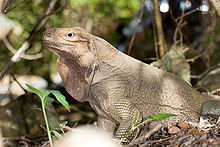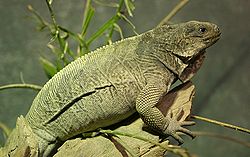- Cyclura pinguis
-
Stout Iguana 
in the wild on Anegada Conservation status Scientific classification Kingdom: Animalia Phylum: Chordata Class: Sauropsida Order: Squamata Suborder: Iguania Family: Iguanidae Genus: Cyclura
Harlan, 1825Species: C. pinguis Binomial name Cyclura pinguis
(Barbour, 1917)The Stout Iguana or Anegada Ground Iguana (Cyclura pinguis) is a critically endangered species of lizard of the genus Cyclura belonging to the Iguanidae family. The species can be found exclusively in the island of Anegada. Historically, it inhabited the islands of Puerto Rico and Saint Thomas, however the animal's original range has been greatly diminished.[1]
Contents
Natural history
The Anegada iguana is noted as the oldest species of Cyclura and the most genetically divergent of the West Indies' rock iguanas.[2][3] An ancestor to this iguana first dispersed to Hispaniola, then onwards to the north and western islands, which has since diversified on different islands into the 9 species and several additional subspecies of the genus Cyclura as we know it today.[4]
Taxonomy
The Anegada rock iguana, Cyclura pinguis, was first described by American Herpetologist Thomas Barbour 1917.[5][6] Its generic name (Cyclura) is derived from the Ancient Greek cyclos (κύκλος) meaning "circular" and ourá (οὐρά) meaning "tail", after the thick-ringed tail characteristic of all Cyclura iguanas, with the exception of the Anegada rock iguana.[7] Its specific name pinguis means "fat" and refers to the animal's stocky appearance and the common name "Stout iguana".[6]
Anatomy and morphology
The Anegada ground iguana is a large heavy-bodied rock iguana which attains a total body length of close to 22 inches(560 mm).[1] As juveniles they are faintly or boldly patterned with wide gray to moss green bands interspersed with wide gray to black anteriorly directed chevrons. These bands fade and are generally lost as the animals mature, turning a uniform grayish or brownish-black with varying amounts of turquoise on the dorsal spines, tail base, fore and hind legs. Occasionally this bluish coloration extends up onto the sides of the individual, particularly in males. Females tend to be relatively dull in color, exhibiting less brilliant blue if any.
Male Anegada iguanas, like other species within the Genus Cyclura, are larger than females, and have more prominent dorsal crests in addition to prominent femoral pores on their thighs, which are used to release pheromones. Females have less prominent pores and have shorter crests than the males making the animals sexually dimorphic.[8][9]
Diet
Like all Cyclura species the Anegada Ground Iguana is primarily herbivorous, consuming leaves, flowers and fruits from different plant species.[1] However, due to direct competition with grazing livestock in its native habitat such as sheep, goats, burros, and cattle they have been reduced to eating vegetation rejected by these domestic and feral animals.[1][2] This has also caused them to become opportunistic carnivores preying upon centipedes, millipedes, roaches, insects, and other invertebrates as opposed to being strict herbivores.[1]
Mating and habitat
 At the Houston Zoo
At the Houston Zoo
This forced diet has had an impact on the iguanas' ability to reproduce.[1] As reproductive females are not being provided with enough nutrition to produce eggs and support their own metabolism; many do not survive after laying eggs, resulting in the present skewed sex ratio of 2 males to every female.[1] Females usually lay one clutch of about 12-16 eggs per year in late spring or early summer.[1][2]
Anegada Island is rare in that it is not a volcanic island, but formed from coral and limestone providing many caves and natural burrows for the iguanas to live.[1] Animals typically inhabit a single burrow and it was once observed that they appeared to bond for life, dwelling in burrows in close proximity to their mate.[1] As the drive to find more females and compete for food has increased their range, this does not appear to be occurring any longer.[1]
Conservation
Endangered status
It is estimated that the current global population is less than 300 and is rapidly declining: the population has decreased by at least 80% over the last 40 years.[1][2][10].[11]
Causes of decline
The primary reason for the Anegeda Ground Iguana's decline is competitive grazing with domestic and feral livestock.[1][2] The secondary reason is that they are preyed upon by feral dogs and cats.[1][2][10] As with other Rock Iguanas, their habitat is also in rapid decline due to development and logging.[1]
Live Anegada iguanas used to regularly be sold to tourists as pets, as their rarity made them more appealing to exotic animal collectors, despite this being illegal under the CITES treaty.[12] In 1999 a World Wildlife Fund international conservation officer, Stuart Chapman, said: "The British government has turned a blind eye for over 20 years to these overseas territories which are home to many rare and endangered species. Many of these face extinction if Britain fails to honour its treaty obligations. The British Caribbean islands are extremely rich in biodiversity with many critically endangered species that are unique to the islands - yet there is virtually zero enforcement or implementation of CITES." [12]
Recovery efforts
Intense conservation efforts are underway to protect this species.[3] In the 1980s, eight iguanas were moved from Anegada to Guana Island, British Virgin Islands, to start a second population in part of the species' former range.[1][13] Guana Island is not a limestone island, and does not provide as many natural retreats as Anegada does. The iguanas appear to be doing well and reproducing in areas free of feral sheep, which is its only competitor for vegetation. Approximately 20 adult iguanas are estimated to inhabit Guana and offspring have been seen each year since 1987.[1] Guana Island Wildlife Sanctuary continues to try to rid the island of sheep, which may improve the habitat for iguanas.[1]
The Anegada Rock Iguana has also been successfully bred in captivity at the San Diego Zoo and the Fort Worth Zoo.[10] Both zoos have actively been working with the British Virgin Islands on a joint-recovery program started in 1997 on Anegeda Island.[10] 120 iguanas have been raised at the facility for release into the wild.[10] Hatchlings are fed and protected so they can be "headstarted" for the wild and not fall prey to feral dogs and cats.[10] This offsets the juvenile mortality rate and is accompanied by field research, nestsite protection, and monitoring of released animals.[10][14]
References
- ^ a b c d e f g h i j k l m n o p q r Mitchell, N. (1996). Cyclura pinguis. 2006. IUCN Red List of Threatened Species. IUCN 2006. www.iucnredlist.org. Retrieved on 8 September 2007.
- ^ a b c d e f "Anegada Iguana". International Iguana Foundation - Anegada Iguana. International Iguana Foundation. 2006-10-21. http://www.iguanafoundation.org/article.php?articleID=68. Retrieved 9/8/2007.
- ^ a b Malone, Catherine; Davis, Scott (2004), "Genetic Contributions to Caribbean Iguana Conservation", Iguanas: Biology and Conservation (University of California Press): pp. 52–57, ISBN 9780520238541
- ^ "Blue Iguana's Relatives". Blue Iguana Recovery Project. http://www.blueiguana.ky/bluevsgreen.htm. Retrieved 9/10/2007.
- ^ "Cyclura pinguis Barbour, 1917", Integrated Taxonomic Information System, 2001, http://www.itis.gov/servlet/SingleRpt/SingleRpt?search_topic=TSN&search_value=202145, retrieved 10/8/2007
- ^ a b Hollingsworth, Bradford D. (2004), "The Evolution of Iguanas: An Overview of Relationships and a Checklist of Species", Iguanas: Biology and Conservation (University of California Press): pp. 38, ISBN 9780520238541
- ^ Sanchez, Alejandro. "Family Iguanidae: Iguanas and Their Kin". Father Sanchez's Web Site of West Indian Natural History Diapsids I: Introduction; Lizards. Kingsnake.com. http://www.kingsnake.com/westindian/metazoa10.html. Retrieved November 26, 2007.
- ^ De Vosjoli, Phillipe; David Blair (1992), The Green Iguana Manual, Escondido, California: Advanced Vivarium Systems, ISBN 74886904040
- ^ Martins, Emilia P.; Lacy, Kathryn (2004), "Behavior and Ecology of Rock Iguanas,I: Evidence for an Appeasement Display", Iguanas: Biology and Conservation (University of California Press): pp. 98–108, ISBN 9780520238541
- ^ a b c d e f g Hudson, Rick (2005), "Anegada Iguanas Released", Iguana Specialist Group Newsletter (International Iguana Foundation) 8 (1): pp. 2–4, http://www.iucn-isg.org/newsletters/pdf/ISG_Bklt_8(1).pdf, retrieved 9/8/2007
- ^ Cogger, Harold; Zweifel, Richard (1992), Reptiles & Amphibians, Sydney, Australia: Weldon Owen, pp. 126, ISBN 0831727861
- ^ a b Tickell, Oliver (1999-10-14), "UK `allowing illicit trade in endangered species'", The (London) Independent
- ^ Iverson, John; Smith, Geoffrey; Pieper, Lynne (2004), "Factors Affecting Long-Term Growth of the Allen Cays Rock Iguana in the Bahamas", Iguanas: Biology and Conservation (University of California Press): pp. 200, ISBN 9780520238541
- ^ Alberts, Allison; Lemm, Jeffrey; Grant, Tandora; Jackintell, Lori (2004), "Testing the Utility of Headstarting as a Conservation Strategy for West Indian Iguanas", Iguanas: Biology and Conservation (University of California Press): pp. 210, ISBN 9780520238541
External links
- Father Sanchez's Website of West Indian Natural History
- Profile on Cyclura.com
- CRES Anegada Iguana Project
Iguanidae Kingdom: Animalia · Phylum: Chordata · Class: Sauropsida · Order: Squamata
Wikimedia Foundation. 2010.


